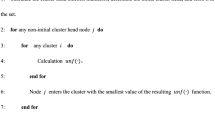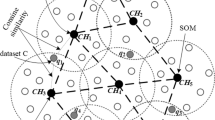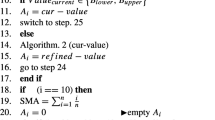Abstract
Wireless sensor networks (WSN) are widely used in various situations. Energy saving is one of the most important issues because of the limited power. Communication is the mainly energy consuming part of sensor nodes. Reducing the size of transmitted data can conserve the energy of nodes. Spatial and temporal correlation is ubiquitous in wireless sensor networks. By exploiting spatial and temporal correlation, only a subset of data need to be transmitted and the rest of the data can be estimated. Data aware clustering is an effective way to exploit spatial correlation among sensor nodes. In our SC-EEDC framework, fuzzy ART artificial neural network is used to measure the shape similarity among data sequences and the magnitude similarity is estimated by a magnitude similarity model. And two corresponding estimation algorithm are proposed. We propose Weighting based K-means clustering algorithm (WK-means), which considers multiple clustering factors in addition to the data similarity. The K-means algorithm structure is introduced in clustering algorithm to search the more energy-saving clustering topology. Anchor node based data collection strategy is proposed to measure the spatial correlation in real time and suppress the transmission of spatial redundant data at source node. Sleeping scheduling is introduced to dynamically adjust the spatial sampling rate and the temporal redundancy is reduced using Length Encoding. The cluster maintenance scheme keeps the cluster structure’s efficiency over the network lifetime. Simulation results show that our SC-EEDC achieves significant data reduction without affecting the accuracy of collected data, reduces the energy consumption in each round of data collection and effectively prolongs the network lifetime.














Similar content being viewed by others
References
Akyildiz, I. F., Su, W., Sankarasubramaniam, Y., & Cayirci, E. (2002). Wireless sensor networks: A survey. Computer Networks, 38(4), 393–422.
Al-Karaki, J. N., & Kamal, A. E. (2004). Routing techniques in wireless sensor networks: a survey. IEEE Wireless Communications, 11(6), 6–28.
Culler, D., Estrin, D., & Srivastava, M. (2004). Gust editors’ introduction: Overview of sensor networks. Computer, 37(8), 41–49.
Ye, M., Li, C., Chen, G., & Wu, J. (2005). EECS: an energy efficient clustering scheme in wireless sensor networks. In PCCC 2005. 24th IEEE International Performance, Computing, and Communications Conference, 2005. (pp. 535–540). IEEE.
Lu, G., Krishnamachari, B., & Raghavendra, C. S. (2007). An adaptive energy-efficient and low-latency MAC for data gathering in wireless sensor networks. Wireless Communications & Mobile Computing, 7(7), 863–875.
Semente, R. S., Oliveira, F. D. M., Lock, A. S., Melo, T. A. C., Junior, S. N., & Salazar, A. O. (2015). Energy-efficient WSN systems. Smart Sensors, Measurement and Instrumentation, 11, 111–132.
Briff, P., Lutenberg, A., Rey Vega, L., Vargas, F., & Patwary, M. (2015). Generalised trade-off model for energy-efficient WSN synchronisation. Electronics Letters, 51(3), 291–292.
Taheri, M., & Motamedi, S. A. (2017). Energy-efficient cooperative localization in mobile WSN. IEEJ Transactions on Electrical and Electronic Engineering, 12(1), 71–79.
Noureddine, M., Abdelbaki, E. B. E. A., & Claude, C. (2017). A snovel approach of WSN routing protocols comparison for forest fire detection. Wireless Networks, 1–11. https://doi.org/10.1007/s11276-018-1872-3.
Aya, A., Oussama, G., Abdulfattah, M. O., & Mohamed, A. (2017). Outlier detection approaches for wireless sensor networks: A survey. Computer Networks, 129, 319–333.
Santosh, K., Sudhir & Umesh, K. T. (2018). Energy efficient target tracking with collision avoidance in WSNs. Wireless Personal Communications,103, 2515–2528.
Murat, D., Xuming, L., & Puneet, S. (2009). An in-network querying frameworks for wireless sensor networks. IEEE Transactions on Parallel and Distributed Systems, 20(8), 1202–1215.
Leandro, A. V., Azzedine, B., & Daniel, L. G. (2013). An energy-aware spatio-temporal correlation mechanism to perform efficient data collection in wireless sensor networks. Computer Communications, 36, 1054–1066.
Otgonchimeg, B., & Youngmi, K. (2010). Adaptive and energy efficient clustering algorithm for event-driven application in wireless sensor networks. Journal of Networks, 5(8), 1796–2056.
Huifang, C., Hiroshi, M., & Tadanori, M. (2008). Adaptive data aggregation scheme in clustered wireless sensor networks. Computer Communications, 31, 3579–3585.
Zhu, Y., Song, J., & Dong, F. (2011). Applications of wireless sensor network in the agriculture environment monitoring. Procedia Engineering, 16, 608–614.
Lee, Y. K., Jung, Y. J., & Ryu, K. H. (2007). Design and implementation of a system for environmental monitoring sensor network. Advances in Web and Network Technologies, and Information Management., 2007, 223–228.
Albaladejo, C., Sanchez, P., & Iborra, A. (2010). Wireless sensor networks for oceanographic monitoring: A systematic review. Sensors, 10(7), 6948–6968.
Chong, L., Kui, W., & Jian, P. (2007). An energy-efficient data collection framework for wireless sensor networks by exploiting spatiotemporal correlation. IEEE Transactions on Parallel and Distributed Systems, 18(7), 1010–1023.
Muruganantham, A., Velunchamy, M., & Erulappan, S. (2015). Distributed similarity based clustering and compressed forwarding for sensor networks. ISA Transactions, 59, 180–192.
Mihaela, I. C., Eduardo, M., Eduardo, A., Julio, R. B., & Antonio, J. C. (2015). Scalable data coupled clustering for large scale WSN. IEEE Transactions on Wireless Communications, 14(9), 4681–4694.
Shah, G. A., & Bozyigit, M. (2007). Exploiting energy-aware spatial correlation in wireless sensor networks. In Proceedings of the 2nd international conference on communication systems software & middleware (Vol. 1–2, p. 821).
Villas, L. A., Boukerche, A., Araujo, R. B., & Loureiro, A. A. (2009). A reliable and data aggregation aware routing protocol for wireless sensor networks. In Proceedings of the 12th ACM international conference on modeling, analysis and simulation of wireless and mobile systems (pp.245–252).
Guiyi, W., Yun, L., Binfeng, G., Bin, X., & Athanasios, V. V. (2011). Prediction-based data aggregation in wireless sensor networks: Combining grey model and Kalman Filter. Computer Communications, 34, 793–802.
Xin, S., Cuirong, W., Jing, G., & Xi, H. (2013). DLRDG:distributed linear regression-based hierarchical data gathering framework in wireless sensor network. Neural Comput & Applications, 23, 1999–2013.
Mou, W., Liansheng, T., & Naixue, X. (2016). Data prediction, compression, and recovery in clustered wireless sensor networks for environmental monitoring applications. Information Sciences, 329, 800–818.
Liu, X., Jun, L., & Athanasios, V. (2011). Compressed data aggregation for energy efficient wireless sensor networks. In Proceedings of the 8th annual IEEE communications society conference on sensor, mesh and ad hoc communications and networks (pp.46–54).
Yu, J. X., Kitsuregawa, M., & Leong, H. V. (2006). In Proceedings of the 7th international conference on advances in web-age information management, lecture notes in computer sciences (p. 4016).
Xiong, Z., Liveris, A. D., & Cheng, S. (2004). Distributed source coding for sensor networks. IEEE Signal Processing Magazine, 21(5), 80–94.
Yoon, S., & Shahabi, C. (2007). The clustered aggregation (CAG) technoque leveraging spatial and temporal correlations in wireless sensor networks. ACM Transactions on Sensor Networks, 3(1), 1–39.
Xiaoling, W., Hainan, C., Yanwen, W., Lei, S., & Guangcong, L. (2016). BP neural network based continuous objects distribution detection in WSNs. Wireless Networks, 22, 1917–1929.
Gedik, B., Liu, L., & Yu, P. (2007). ASAP: An adaptive sampling approach to data collection in sensor networks. Parallel and Distributed Systems, 18(12), 1766–1783.
Hanaa, Z. E., Mostafa, A. E., & Hesham, A. A. (2015). Image compression algorithms in wireless multimedia sensor networks: A survey. Ain Shams Engineering Journal, 6, 481–490.
Nesrine, K., Jean-Francois, C., & Ahmed, M. (2018). Maximum network lifetime with optimal power/rate and routing trade-off for Wireless Multimedia Sensor Networks. Computer Communication, 124, 1–16.
Manjunatha, P., Verma, A. K., & Srividya, A.(2008). Multi-sensor data fusion in cluster based wireless sensor networks using fuzzy logic method. In IEEE region 10 and the third international conference on industrial and information systems (pp. 2167–7011).
Sandeep, K. A., Shrinivasa, K., & Srinivasan, R. (2009). Bounds on coverage time and node density for multi-modality sensing. Ad Hoc Networks, 7(7), 1302–1314.
Guanghui, H., & Licui, Z. (2018). WPO-EECRP: Energy-efficient clustering routing protocol based on weighting and parameter optimization in WSN. Wireless Personal Communications, 98, 1171–1205.
Heinzelman, W., Chandrakasan, A., & Balakrishnan, H. (2000). Energy-efficient communication protocol for WSNs. In Proceedings of the 33rd Hawaii international conference on system sciences.
Vlajic, N., & Xia, D. (2006). Wireless sensor networks: to cluster or not to cluster? In Proeedings of the international symposium on world of wireless, mobile and multimedia networks (pp. 26–29).
Ali, Q., Abdulmaowjod, A., & Mohammed, H. (2010). Simulation and performance study of wireless sensor network (WSN) using MATLAB. In Proceedings of the 1st IEEE international conference on energy, power and control.
Abdel-Wahab, M., Essa, K., Embaby, M., & Elsaid, S. (2012). Some characteristic parameters of Gaussian plume model. MAUSAM, 63(1), 123–128.
Author information
Authors and Affiliations
Corresponding author
Additional information
Publisher's Note
Springer Nature remains neutral with regard to jurisdictional claims in published maps and institutional affiliations.
Rights and permissions
About this article
Cite this article
Licui, Z., Pengcheng, W. & Chunxia, Z. SC-EEDC: Similarity Based Clustering for Energy Efficient Data Collection in WSN. Wireless Pers Commun 117, 655–687 (2021). https://doi.org/10.1007/s11277-020-07892-0
Accepted:
Published:
Issue Date:
DOI: https://doi.org/10.1007/s11277-020-07892-0




